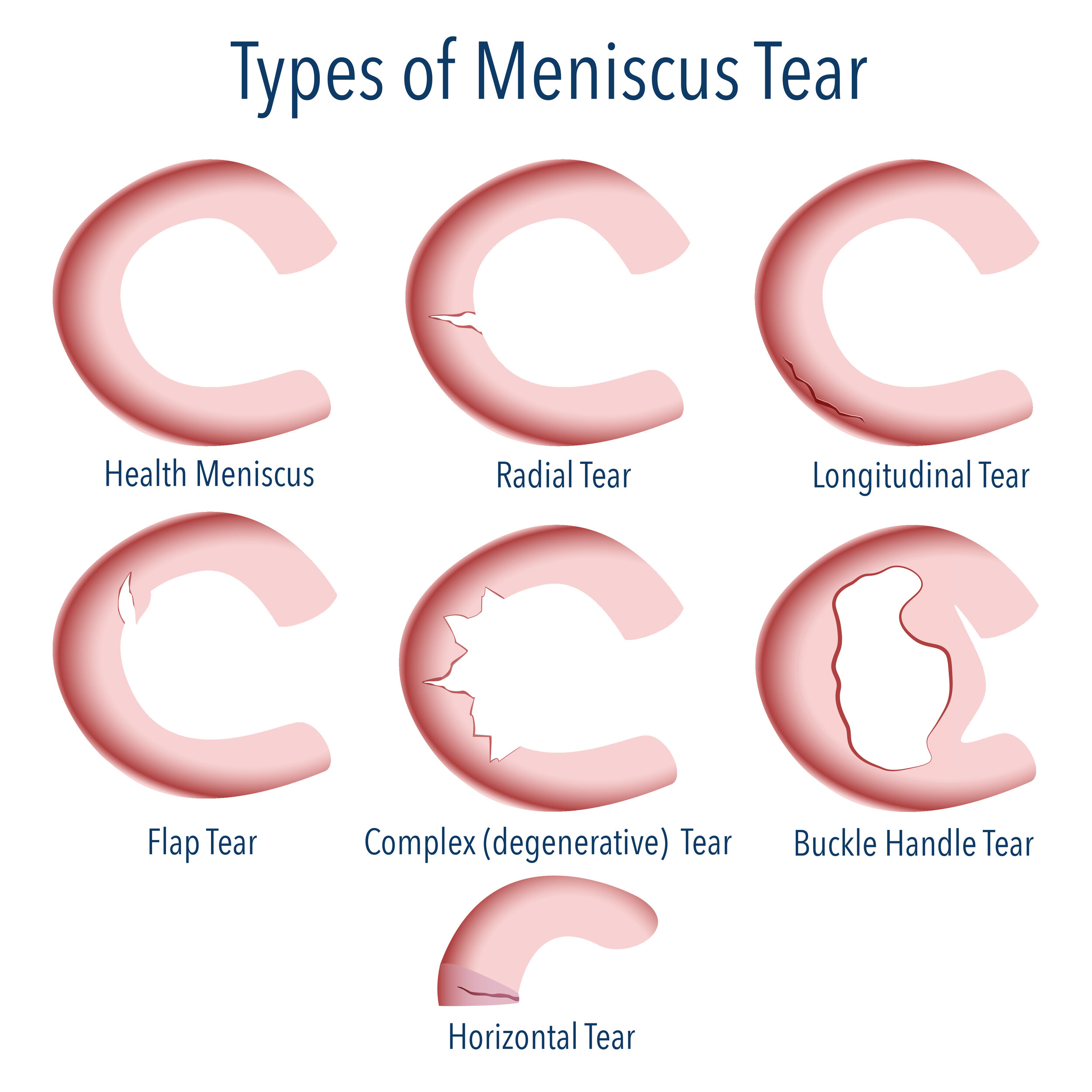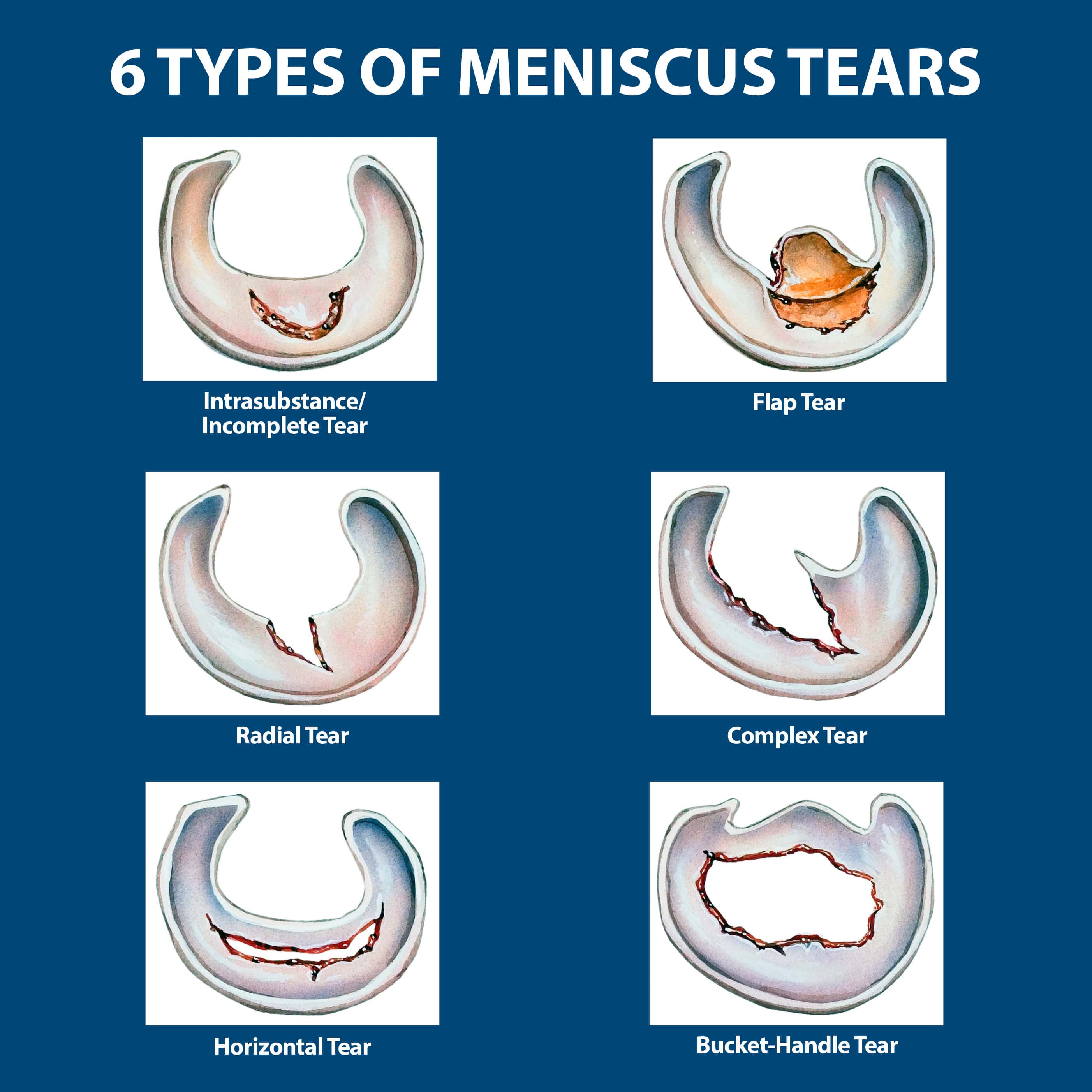Anatomy and Function of the Meniscus: Meniscus Tear

The menisci are two C-shaped pieces of fibrocartilage located within the knee joint. They act as shock absorbers, distribute weight evenly across the joint, and contribute to joint stability.
Location and Structure
The menisci reside between the femur (thighbone) and the tibia (shinbone). They are positioned on either side of the knee joint, with the medial meniscus on the inner side and the lateral meniscus on the outer side. The menisci are composed of tough, fibrous cartilage that is less flexible than hyaline cartilage found in other joints. This structure allows them to withstand the high forces that are placed on the knee joint during activities such as walking, running, and jumping.
Roles of the Menisci
- Shock Absorption: The menisci act as shock absorbers, distributing the weight of the body across the knee joint. This helps to protect the cartilage and other tissues of the joint from damage.
- Joint Stability: The menisci contribute to the stability of the knee joint by deepening the joint space and increasing the contact area between the femur and tibia. This helps to prevent the bones from moving out of alignment.
- Joint Lubrication: The menisci also play a role in joint lubrication. They help to distribute synovial fluid, which is a lubricating fluid that reduces friction within the joint.
Knee Joint Illustration
Imagine a knee joint with the femur positioned above the tibia. The menisci are located between these two bones, with the medial meniscus on the inside of the knee and the lateral meniscus on the outside. The menisci are crescent-shaped, and their curved edges are attached to the tibia. The outer edges of the menisci are not attached to any bone but are held in place by ligaments and tendons. The patella (kneecap) sits in front of the femur and glides over the joint during knee movements.
Types and Causes of Meniscus Tears

Meniscus tears are common injuries that can affect people of all ages. They occur when the meniscus, a C-shaped piece of cartilage that acts as a shock absorber in the knee joint, is torn. The location, shape, and severity of the tear determine the type of meniscus tear. Understanding the different types and their causes is crucial for proper diagnosis and treatment.
Types of Meniscus Tears
The classification of meniscus tears is based on their location, shape, and severity.
- Location: Tears can occur in the medial meniscus (inner side of the knee) or the lateral meniscus (outer side of the knee).
- Shape: Tears can be horizontal, vertical, radial, oblique, or complex.
- Severity: Tears can be partial (involving only a portion of the meniscus) or complete (involving the entire width of the meniscus).
Some common types of meniscus tears include:
- Bucket-handle tear: A large, vertical tear that resembles a bucket handle.
- Flapper tear: A horizontal tear that detaches a portion of the meniscus from the knee joint.
- Degenerative tear: A tear that occurs due to wear and tear on the meniscus, often in older individuals.
Causes of Meniscus Tears
Meniscus tears can occur due to a variety of factors, including:
- Sports Injuries: Sports that involve pivoting, twisting, or sudden changes in direction, such as football, basketball, and skiing, are common causes of meniscus tears.
- Degenerative Changes: As we age, the meniscus can become thinner and weaker, making it more susceptible to tears.
- Trauma: A direct blow to the knee, such as a car accident or a fall, can cause a meniscus tear.
Mechanisms of Injury for Different Types of Meniscus Tears
The mechanism of injury for a meniscus tear depends on the type of tear.
- Bucket-handle tear: This type of tear often occurs when the knee is twisted or rotated while the foot is planted. The meniscus is compressed between the femur and tibia, causing the tear.
- Flapper tear: This type of tear can occur when the knee is hyperextended or when the knee is struck directly from the front.
- Degenerative tear: This type of tear is often caused by repeated stress on the meniscus over time.
Symptoms and Diagnosis of Meniscus Tears

A meniscus tear can cause a variety of symptoms, depending on the severity of the tear and the location of the injury. Understanding the common symptoms and diagnostic methods is crucial for accurate diagnosis and appropriate treatment.
Symptoms of Meniscus Tears
Meniscus tears can manifest in various ways, and recognizing these symptoms is essential for prompt medical attention. Common symptoms include:
- Pain: A sharp, sudden pain in the knee, often occurring during an injury or twisting motion. This pain can worsen with activity and may persist even at rest.
- Swelling: Swelling in the knee joint, often occurring immediately after the injury or within a few hours.
- Clicking or Popping: A sensation of clicking or popping in the knee, particularly during movement. This is often caused by the torn meniscus fragment moving within the joint.
- Locking: The knee may lock or catch in a bent position, making it difficult to straighten. This occurs when a piece of the torn meniscus becomes trapped between the bones of the knee joint.
- Stiffness: The knee may feel stiff and difficult to bend or straighten, particularly in the morning or after a period of rest.
- Giving way: The knee may give way or feel unstable, particularly during activities that involve twisting or pivoting.
Diagnostic Procedures for Meniscus Tears
Diagnosing a meniscus tear typically involves a combination of physical examination, imaging tests, and, in some cases, arthroscopy.
Physical Examination
A thorough physical examination by a healthcare professional is essential to assess the knee’s range of motion, stability, and tenderness. The doctor will perform various tests, such as:
- McMurray’s Test: This test involves rotating the knee while applying pressure to the joint. A clicking or popping sound during this maneuver may indicate a meniscus tear.
- Apley’s Compression Test: This test involves applying pressure to the knee while rotating the lower leg. Pain during this test may suggest a meniscus tear.
- Lachman’s Test: This test assesses the stability of the anterior cruciate ligament (ACL), which is often injured in conjunction with a meniscus tear.
Imaging Tests
Imaging tests play a crucial role in confirming the diagnosis and determining the extent of the tear. Common imaging modalities include:
- Magnetic Resonance Imaging (MRI): An MRI provides detailed images of the soft tissues, including the meniscus. It is considered the gold standard for diagnosing meniscus tears.
- X-ray: While X-rays primarily visualize bones, they can help rule out other conditions, such as fractures or arthritis, that may mimic meniscus tear symptoms.
Arthroscopy
Arthroscopy is a minimally invasive surgical procedure that allows direct visualization of the knee joint. It is often performed when other diagnostic methods are inconclusive or when surgery is being considered. During arthroscopy, a small camera is inserted into the joint, providing a clear view of the meniscus and surrounding structures. This procedure can confirm the diagnosis, assess the extent of the tear, and allow for surgical repair if necessary.
Types of Meniscus Tears and Their Characteristics
Meniscus tears can be classified based on their location, severity, and pattern of the tear. Here’s a table summarizing the key characteristics of different types of meniscus tears:
| Type of Tear | Location | Characteristics | Symptoms | Causes | Diagnostic Methods |
|---|---|---|---|---|---|
| Horizontal Tear | Across the width of the meniscus | Often occurs in the outer portion of the meniscus | Pain, swelling, clicking, locking | Twisting injury, direct blow to the knee | Physical examination, MRI |
| Vertical Tear | From the top to the bottom of the meniscus | Can involve the inner or outer portion of the meniscus | Pain, swelling, clicking, locking | Twisting injury, direct blow to the knee | Physical examination, MRI |
| Bucket-Handle Tear | A large, flap-like tear that extends from the inner to the outer edge of the meniscus | Often causes significant knee instability | Pain, swelling, locking, giving way | Twisting injury, direct blow to the knee | Physical examination, MRI, arthroscopy |
| Degenerative Tear | Occurs due to wear and tear over time | Often found in older individuals | Pain, swelling, stiffness | Aging, overuse, osteoarthritis | Physical examination, MRI |
A meniscus tear, a common injury in athletes, occurs when the cartilage in the knee is torn. This tough, rubbery tissue acts as a shock absorber, protecting the joint. The injury can range from a small tear to a complete tear, often requiring surgery to repair.
The recent justin jefferson injury highlights the devastating impact a meniscus tear can have on an athlete’s performance, as it can significantly impact mobility and stability in the knee joint. Understanding the mechanics of this injury is crucial for both athletes and healthcare professionals to effectively prevent and manage it.
A meniscus tear, a common knee injury, occurs when the C-shaped cartilage that cushions the joint is damaged. This can happen suddenly, like a football player taking a hard hit, or gradually over time, due to wear and tear.
Think of the grit and determination of the Minnesota Vikings , a team known for its powerful plays and relentless defense. Just like a Viking warrior, a meniscus tear can impact your ability to move freely and confidently.
While recovery time varies, rest, physical therapy, and sometimes surgery can help restore knee function.
